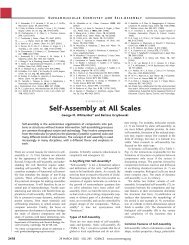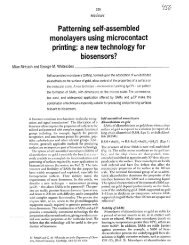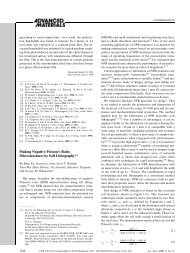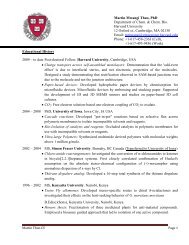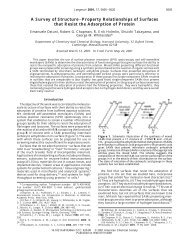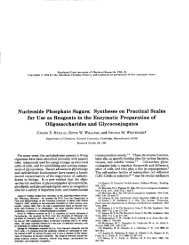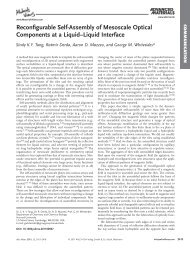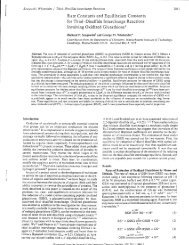Self-Assembled Monolayers of Thiolates on Metals as - Whitesides ...
Self-Assembled Monolayers of Thiolates on Metals as - Whitesides ...
Self-Assembled Monolayers of Thiolates on Metals as - Whitesides ...
Create successful ePaper yourself
Turn your PDF publications into a flip-book with our unique Google optimized e-Paper software.
1126 Chemical Reviews, 2005, Vol. 105, No. 4 Love et al.<br />
Table 3. Examples <str<strong>on</strong>g>of</str<strong>on</strong>g> Polymers Grafted to SAMs via Surface Initiati<strong>on</strong><br />
polymer mechanism ref<br />
polystyrene photoinitiated radical polymerizati<strong>on</strong> 379<br />
thermal radical polymerizati<strong>on</strong> 380<br />
living ani<strong>on</strong>ic polymerizati<strong>on</strong> 381<br />
polyacryl<strong>on</strong>itrile photoinitiated radical polymerizati<strong>on</strong> 382<br />
polyacrylamide ATRP 383<br />
poly(norbornene) ring-opening metathesis 384<br />
poly(methyl methacrylate) ATRP 385<br />
poly(glycidyl methacrylate) ATRP 385<br />
poly(butyl methacrylate) ATRP 385<br />
poly(2-hydroxyethyl methacrylate) ATRP 385<br />
polylactide ring-opening polymerizati<strong>on</strong> 386<br />
poly(p-dioxan<strong>on</strong>e) ring-opening polymerizati<strong>on</strong> 387<br />
enzymatic polymerizati<strong>on</strong> 388<br />
poly(3-hydroxybutyrate) enzymatic polymerizati<strong>on</strong> 389<br />
poly(ethylene glycol dimethacrylate) ATRP 390<br />
poly(ɛ-caprolact<strong>on</strong>e) enzymatic 388<br />
ring-opening polymerizati<strong>on</strong> 386<br />
a ATRP ) Atom transfer radical polymerizati<strong>on</strong>.<br />
yields a free carboxylic acid terminus. 370 This reacti<strong>on</strong><br />
does not generate a reactive intermediate directly,<br />
but the free acid is useful for attaching ligands by<br />
the methods described above.<br />
5.2.3. Reacti<strong>on</strong>s that Break Covalent B<strong>on</strong>ds<br />
A third strategy for modifying the interfacial<br />
compositi<strong>on</strong> <str<strong>on</strong>g>of</str<strong>on</strong>g> a SAM is the cleavage <str<strong>on</strong>g>of</str<strong>on</strong>g> covalent<br />
b<strong>on</strong>ds <str<strong>on</strong>g>of</str<strong>on</strong>g> a terminal surface group. 371 Mrksich et al.<br />
dem<strong>on</strong>strated that quin<strong>on</strong>es modified with propi<strong>on</strong>ic<br />
esters can undergo an intramolecular cyclizati<strong>on</strong><br />
up<strong>on</strong> electrochemical reducti<strong>on</strong>; ligands bound to the<br />
propi<strong>on</strong>ic ester moiety are rele<strong>as</strong>ed with the formati<strong>on</strong><br />
<str<strong>on</strong>g>of</str<strong>on</strong>g> a lact<strong>on</strong>e. 372 Similarly, O-silyl hydroquin<strong>on</strong>es<br />
will rele<strong>as</strong>e the silyl group via electrochemical oxidati<strong>on</strong><br />
and hydrolysis. 373 This approach can rele<strong>as</strong>e a<br />
bound molecule into soluti<strong>on</strong> and generate a new<br />
organic surface for subsequent reacti<strong>on</strong>s. Sortino and<br />
co-workers have shown that SAMs presenting an<br />
anti-cancer drug, flutamide, can rele<strong>as</strong>e nitric oxide<br />
when the surface is irradiated with ultraviolet (UV)<br />
light. 374<br />
5.2.4. Surface-Initiated Polymerizati<strong>on</strong>s<br />
Polymer coatings can c<strong>on</strong>tribute durability and<br />
toughness to SAMs. Two methods for attaching, or<br />
grafting, polymers to SAMs are (1) covalently linking<br />
preformed polymer chains to reactive SAM surfaces<br />
and (2) growth <str<strong>on</strong>g>of</str<strong>on</strong>g> the polymer directly <strong>on</strong> the SAM<br />
from a terminal functi<strong>on</strong>al group that can act <strong>as</strong> an<br />
initiati<strong>on</strong> site. Examples <str<strong>on</strong>g>of</str<strong>on</strong>g> polymers attached to<br />
SAMs by the first method include polyethyleneimine/<br />
poly(ethylene-alt-maleic anhydride) 375 and poly-<br />
(acrylic acid)/poly(ethylene glycol). 376 A number <str<strong>on</strong>g>of</str<strong>on</strong>g><br />
polymers also have been formed by surface-initiated<br />
growth processes <strong>on</strong> SAMs <str<strong>on</strong>g>of</str<strong>on</strong>g> alkanethiolates (Table<br />
3); it also is possible to grow block copolymers <strong>on</strong><br />
surfaces by this method. 377 These methods, the types<br />
<str<strong>on</strong>g>of</str<strong>on</strong>g> polymers grafted, and the mechanisms for growth<br />
have been reviewed. 378<br />
5.2.5. How Does the Structure <str<strong>on</strong>g>of</str<strong>on</strong>g> the SAM Influence<br />
Reactivity <strong>on</strong> Surfaces?<br />
Reacti<strong>on</strong>s that involve functi<strong>on</strong>al groups immobilized<br />
at a surface are subject to certain geometric<br />
c<strong>on</strong>straints and envir<strong>on</strong>mental variati<strong>on</strong>s that are<br />
not present in soluti<strong>on</strong>. The surface can limit the<br />
accessibility <str<strong>on</strong>g>of</str<strong>on</strong>g> interfacial functi<strong>on</strong>al groups, and<br />
there is evidence that the nature <str<strong>on</strong>g>of</str<strong>on</strong>g> the soluti<strong>on</strong><br />
(solvent density, viscosity, pH, i<strong>on</strong> c<strong>on</strong>centrati<strong>on</strong>s) at<br />
interfaces can differ significantly from the bulk<br />
soluti<strong>on</strong>. 282,391,392 Other factors also can influence the<br />
kinetics <str<strong>on</strong>g>of</str<strong>on</strong>g> reacti<strong>on</strong>s <strong>on</strong> a SAM: (1) the organizati<strong>on</strong><br />
<str<strong>on</strong>g>of</str<strong>on</strong>g> the chains in the m<strong>on</strong>olayer (crystalline, disordered),<br />
(2) the density and orientati<strong>on</strong> <str<strong>on</strong>g>of</str<strong>on</strong>g> the functi<strong>on</strong>al<br />
groups <strong>on</strong> the surface, (3) lateral steric effects,<br />
(4) the partiti<strong>on</strong>ing <str<strong>on</strong>g>of</str<strong>on</strong>g> the free reactants at the<br />
interface, and (5) the distance <str<strong>on</strong>g>of</str<strong>on</strong>g> the functi<strong>on</strong>al group<br />
from the interface between the SAM and the soluti<strong>on</strong>.<br />
Effects <str<strong>on</strong>g>of</str<strong>on</strong>g> the Organizati<strong>on</strong> and Density <str<strong>on</strong>g>of</str<strong>on</strong>g><br />
Molecules. The crystallinity <str<strong>on</strong>g>of</str<strong>on</strong>g> a SAM can influence<br />
the kinetics <str<strong>on</strong>g>of</str<strong>on</strong>g> reacti<strong>on</strong>s <strong>on</strong> its functi<strong>on</strong>al groups.<br />
Schönherr et al. used ex-situ RAIRS to me<strong>as</strong>ure the<br />
effect <str<strong>on</strong>g>of</str<strong>on</strong>g> chain organizati<strong>on</strong> <strong>on</strong> the rate c<strong>on</strong>stants <str<strong>on</strong>g>of</str<strong>on</strong>g><br />
the b<strong>as</strong>e-catalyzed hydrolysis <str<strong>on</strong>g>of</str<strong>on</strong>g> NHS esters. 393 NHS<br />
esters at the termini <str<strong>on</strong>g>of</str<strong>on</strong>g> SAMs <str<strong>on</strong>g>of</str<strong>on</strong>g> undecanethiolates<br />
hydrolyzed more rapidly than those <strong>on</strong> SAMs <str<strong>on</strong>g>of</str<strong>on</strong>g><br />
hexadecanethiolates. Both reacti<strong>on</strong>s progressed more<br />
slowly (by <strong>as</strong> much <strong>as</strong> 2 orders <str<strong>on</strong>g>of</str<strong>on</strong>g> magnitude) than<br />
the hydrolysis reacti<strong>on</strong> <str<strong>on</strong>g>of</str<strong>on</strong>g> the precursor molecules in<br />
soluti<strong>on</strong>. In a similar set <str<strong>on</strong>g>of</str<strong>on</strong>g> experiments, Vaidya et<br />
al. dem<strong>on</strong>strated that the rate <str<strong>on</strong>g>of</str<strong>on</strong>g> hydrolysis for<br />
terminal ester groups <strong>on</strong> SAMs formed from structural<br />
isomers depends <strong>on</strong> the density and orientati<strong>on</strong><br />
<str<strong>on</strong>g>of</str<strong>on</strong>g> the organic comp<strong>on</strong>ents; 394 these m<strong>on</strong>olayers were<br />
also less reactive than the corresp<strong>on</strong>ding hydrolysis<br />
reacti<strong>on</strong>s in soluti<strong>on</strong>. These results suggest that<br />
functi<strong>on</strong>al groups positi<strong>on</strong>ed within highly ordered<br />
organic interfaces can have poor reactivities and<br />
that c<strong>on</strong>formati<strong>on</strong>al and steric effects are important<br />
factors in determining the reactivity <str<strong>on</strong>g>of</str<strong>on</strong>g> a surface.<br />
Lateral Steric Effects. In some c<strong>as</strong>es, steric<br />
crowding between reactive sites adjacent to <strong>on</strong>e<br />
another within a SAM also can influence interfacial<br />
reacti<strong>on</strong>s. Houseman and Mrksich observed that the<br />
enzymatic activity <str<strong>on</strong>g>of</str<strong>on</strong>g> bovine �-1,4-galactosyltransfer<strong>as</strong>e<br />
incre<strong>as</strong>ed linearly when molecules presenting<br />
an appropriate reactant (N-acetylglucosamine) c<strong>on</strong>stituted<br />
e70% <str<strong>on</strong>g>of</str<strong>on</strong>g> a mixed SAM; the activity decre<strong>as</strong>ed




